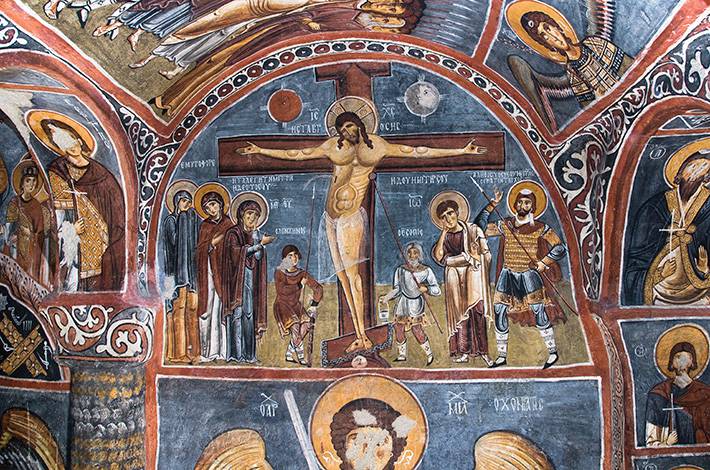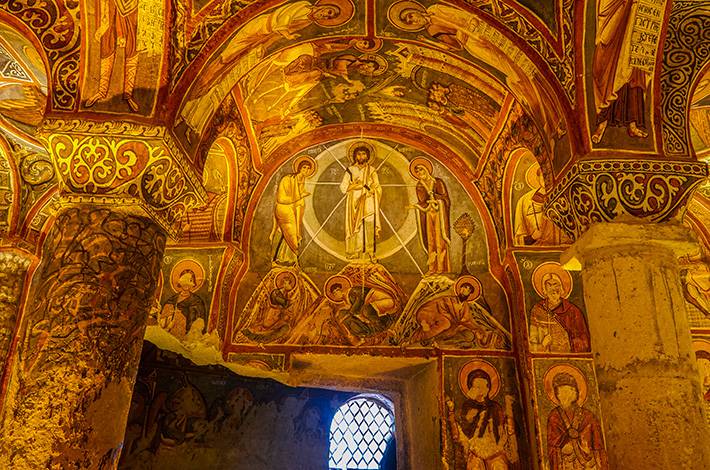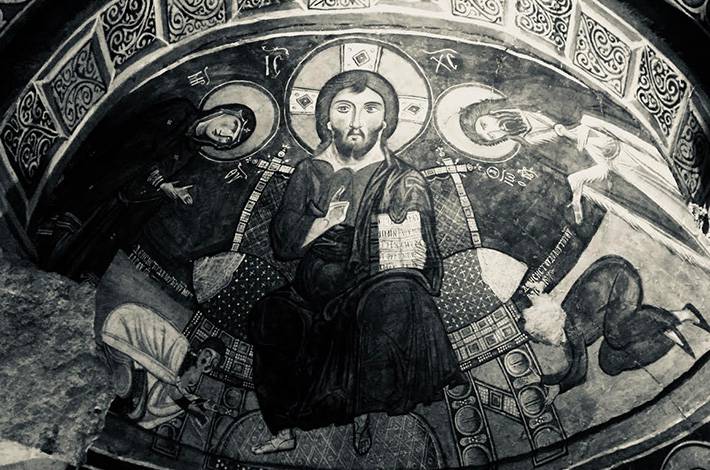Dark Church is located within the Göreme Open Air Museum in the town of Göreme, in the province of Nevşehir, Türkiye. The structure is one of the rock churches carved out of the soft tuff rock characteristic of the Cappadocia region. Belonging to one of the extensive monastery complexes in Cappadocia, the Dark Church reflects examples of Byzantine art dating back to the late 11th century and early 12th century.

Dark Church (Turkey Culture Portal)
Architectural Structure and Plan
The church has a cruciform plan. It consists of a dome at the center, four columns supporting the dome, the arms of the cross, three apses, and a vaulted roof system. The building material used is tuff rock, which is characteristic of the region. The narthex is covered with a barrel vault and is accessed via a sloping staircase from the north. There is a burial niche on the south side of the narthex. The architecture of the main hall is consistent with the cross-shaped and domed church architecture seen in the early and middle Byzantine periods. The surfaces where the scenes are placed were smoothed before plastering and painting.
Lighting and Naming
The structure was named “Dark Church” because there is only one small window in the narthex, which allows very little light to enter. The interior is poorly lit by natural light, which has preserved the color pigments used in the frescoes for a long time. These physical conditions have enabled the frescoes to reach the present day with their vivid colors.
 Interior of the Church (Museum Card Official Website)
Interior of the Church (Museum Card Official Website)
Fresco Program and Iconography
The walls and dome surfaces of the Dark Church feature religious scenes from the Bible and the Torah. The frescoes contain themes commonly found in medieval Christian art from an iconographic perspective. The paintings are mostly done in the fresco technique. The main scenes depicted in the frescoes are as follows:
- Deesis
- Annunciation
- Journey to Bethlehem
- Nativity
- Adoration of the Magi
- Baptism
- Resurrection of Lazarus
- Transfiguration
- Entry into Jerusalem
- Last Supper
- Betrayal
- Crucifixion of Jesus
- Descent into Hell
- Women at the Empty Tomb
- The Consecration and Commissioning of the Apostles
- The Ascension of Jesus
- The Hospitality of Abraham
- The Burning of the Three Jewish Youths
 Crucifixion Scene (Museum Card Official Website)
Crucifixion Scene (Museum Card Official Website)
 Frescoes (Museum Card Official Website)
Frescoes (Museum Card Official Website)
The scenes are arranged in a symmetrical pattern, preserving the integrity of the religious narrative. The dome, apses, and side walls are decorated with compositions that maintain iconographic continuity.
Restoration and Conservation
The church remained closed until the last quarter of the 20th century and was not exposed to daylight during this period. This contributed to the preservation of the frescoes from physical deterioration. Cleaning, stabilization, and pigment conservation were carried out as part of the restoration work.
Visiting and Use
The Dark Church is located within the Göreme Open Air Museum and can be visited for an additional fee in addition to the museum's general entrance fee. The church is introduced to visitors by a guide or through information panels. Flash photography is not permitted inside the church, and light levels are kept low to protect the frescoes.
 Frescoes (Museum Card Official Website)
Frescoes (Museum Card Official Website)
Touristic and Cultural Significance
Located in the Cappadocia region, the Dark Church is one of the best-preserved structures with frescoes among the numerous rock churches in the area. It holds significant importance in terms of Christian art history and medieval iconography. As one of the main components of the Göreme Open Air Museum, which is on the UNESCO World Heritage List, it has research potential in terms of history, architecture, art, and religious studies.
The Dark Church is an important example of Christian life and art in Anatolia during the Middle Ages. The architecture of the structure, its rock-carving technique, fresco program, and state of preservation serve as a regional and period reference point in both scientific and cultural evaluations. When compared to similar structures in Cappadocia, it is a significant site due to the integrity and level of detail of its frescoes.


